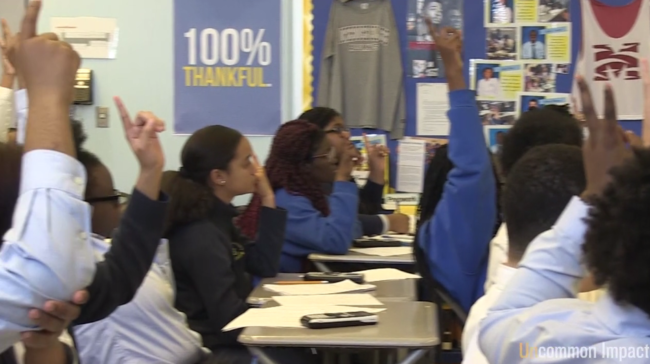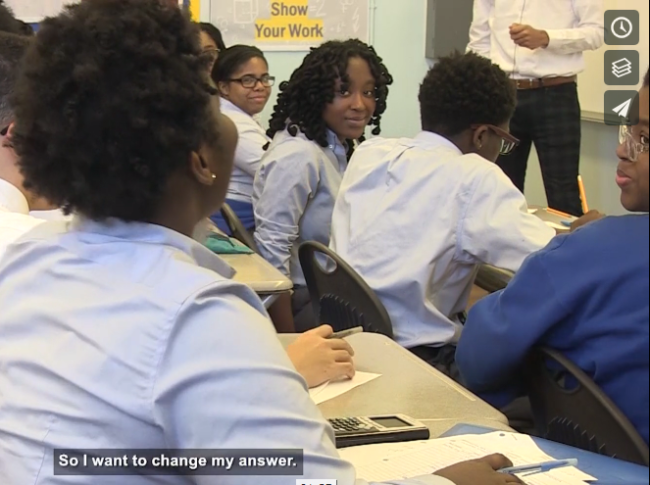05.08.19A Case Study in the Power of Academic Procedures and Routines

Perhaps the single most powerful way to bring efficiency, focus and rigor to a classroom is by installing strong procedures and routines. You define a right way to do recurring tasks; you practice doing them with students so they roll like clockwork.
This applies at least as much to ‘academic’ tasks as it does to more procedural ones. When a teacher says, “Turn and Talk to your partner: How will the weight of the nucleus change? Go!” or “Take a minute to jot your thoughts: How will the weight of the nucleus change? Go!” the room should crackle to life with every student engaged within a second or two.
Some skeptics argue that this is controlling or paternalistic, but you would only say that if you didn’t understand what students get back when such routines are in place, and this video of Denarius Frazier’s math class makes that case perfectly.
EA.CFU.GR11.Frazier.’Solutions.’Clip2858.shorter from TLAC Blog on Vimeo.
You will surely note the rigor of the mathematical discussion, the high “ratio” in the classroom–every student doing every task and the tasks being challenging and worthy. You might also note the outstanding work done by the young woman who begins to defend what turns out to be a wrong answer, and who then recognizes her mistake and changes her thinking without defensiveness or anxiety. Honestly it’s a thing of beauty, this class.
And it is what it is in part because of the time Denarius has taken to install procedures for so many recurring academic behaviors and turn them into routine. For example:
- Tracking (students looking at the speaker). In the photo below the young woman correcting herself is receiving a powerful message from her classmates: “Your words and ideas matter. We are listening. We support you.” No one takes the risk of sharing honest, forthright thoughts into a room where the body language of their peers says: “Yawn. How long til class is over?” or: “I couldn’t care less what you think about reciprocals.” I’d wager that the people shouting about how coercive and demeaning tracking is have never lived the difference.

- Polling/Hand Signals–This lesson works because Denarius is able to understand quickly where his students stand on the math by asking them to digitize their answers on their fingers quickly and seamelessly. When he says, “Where are we? In 3, 2 and 1…” every student responds on cue and without looking at their peers to bail them out. There’s a system for gathering data. It starts there. But don’t think it didn’t take some practice to install it.
- Turn and Talk–“We’re a little divided,” Denarius says. “Turn and Talk: Why?” Within two seconds every student is participating and discussing the math. Even the student sitting without a partner next to her knows how to jump in with the group ahead of her.
- Cold Call–Coming out of the Turn and Talk Denarius doesn’t wait for hands. He says, “Let’s talk about A. Track… Brittany…” and Brittany answers. She hasn’t raised her hand, but she’s happy to engage. She knows Denarius is, in calling on her, telling her that her voice and her learning matter. She doesn’t hesitate for a second because the Cold Calling is a procedure. She and all her classmates know it’s coming. Incidentally it’s a great tool for building a bit of tacit accountability for the work done during the Turn and Talk.
- Snaps for agreement–As she’s talking students snap their agreement. This lets them show support and interest for a peer’s comments without interrupting. It keeps the energy high and the pacing crisp. It reminds Brittany that her peers are listening carefully to her thoughts about math and that they want her to succeed.
- Hands–There’s also a system for raising hands. People don’t call out in Denarius’ class. If they did he could not allow for Wait Time as he brilliantly does several times int he clip
- The young scholar who raises her hand to disagree with Brittany cites her notes. Denarius wants that to happen. Note taking matters. So he has a system for how they do it, to make sure they do it and to make sure that their notes are always accessible. You’ll notice that the discussion ends with Fagan framing the “takeaways” and Denarius reminding everyone to write them down. On the board, beneath the two answers they’ve been discussing is the word “stamp.” A stamp is an academic procedure too: the thing we do at the end of any discussion where we distill in writing what we’ve learned.
Anyway, I thought it was important to show what was possible when teachers take the time to make a routine out of key recurring tasks. And thanks to Denarius and his students at Uncommon Collegiate High School for everything they’ve taught us. (PS Everyone in this year’s graduating class is going to college.)